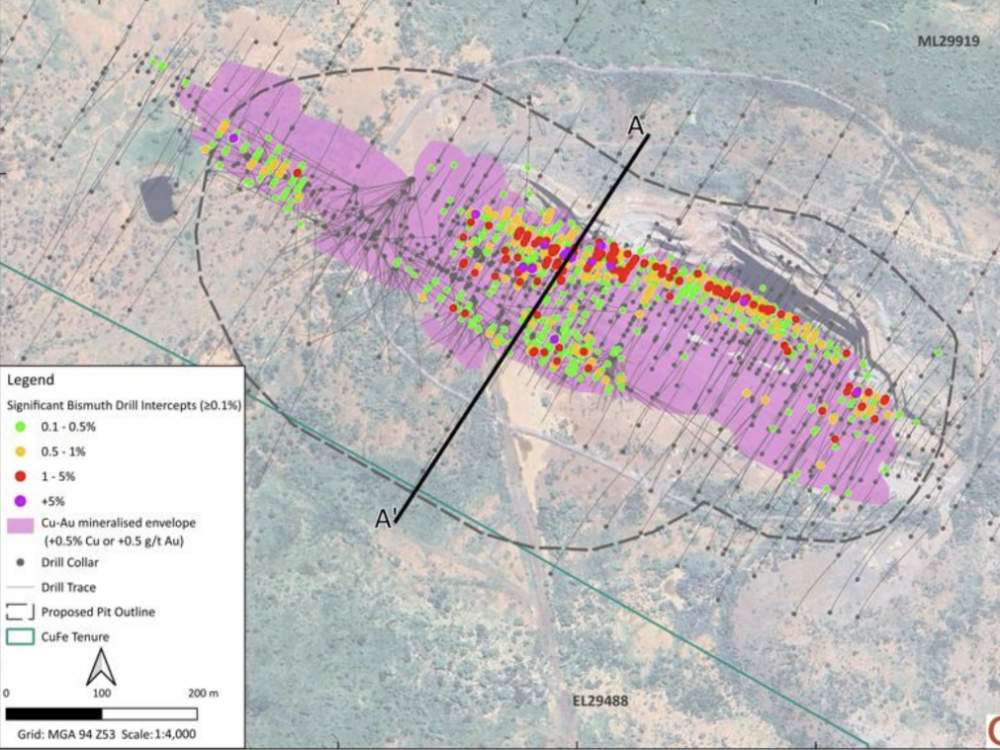Orlando blooming as CuFe adds bismuth and silver to copper-gold resource

CuFe now has one of the largest bismuth resources in Australia. Pic: Getty Images
- CuFe adds 4421t bismuth and 266,000oz silver to Orlando’s gold-copper resource
- Tennant Creek now holds one of Australia’s largest bismuth resources at 18,224t
- Bismuth stockpile equals roughly one year of global production for critical mineral
Special Report: CuFe has boosted resources at the Orlando deposit within its Tennant Creek project in the Northern Territory with the inclusion of bismuth and silver.
Orlando now has an indicated and inferred resource of nearly 6Mt grading 3.12g/t gold equivalent, or contained resources of 288,000oz gold, 69,000t copper, 266,000oz Ag and 4421t Bi.
This takes the total resource at Tennant Creek up to 24.4Mt at 1.8% Cu and 0.55g/t Au including 18,224t contained Bi and 2.03Moz Ag, making it one of Australia’s largest bismuth resources.
Bismuth is one of a limited number of minerals included on the critical mineral lists of the US, EU, UK, India, South Korea and Japan.
CuFe (ASX:CUF) notes that bismuth and silver mineralisation at Orlando is coincident with the copper and gold mineralisation envelopes, occurring as high-grade pods within the ore lenses and likely to add significant value to project economics.
The Orlando scoping study will be updated to reflect the inclusion of these commodities.
“This resource update has boosted the project’s bismuth resources of Orlando and Gecko to 18,224 tonnes, and over 2Moz of silver and has consolidated CuFe’s position as a holder of one of the largest bismuth resources in Australia at a point in time where global supply concerns for this critical mineral are growing,” executive director Mark Hancock said.
“As context the Tennant Creek bismuth resource is now approximately one year of global production for this critical mineral, which is an excellent position for an emerging company such as ours.
“The resource update allows us to study and determine what the optimum revenue streams of what are now truly poly metallic deposits and understand their impacts of capital and operational costs.
“The mineral field has been a producer of a considerable amount of bismuth and silver in the past as by-products of copper and gold and the quantum of the metal content across the Orlando and Gecko resource provides numerous opportunities to explore which have not been tested under modern day metal prices and economics.”

Orlando deposit
The Orlando deposit sits within ML29919 of the 55%-owned Tennant Creek project about 25km northwest of Tennant Creek town.
It was first drilled by Peko in 1957 with first ore extracted in 1962 from an underground mine.
The underground operation produced 322,060t of ore, yielding 121,282oz of gold and 4852t of copper before halting in 1975 due to low copper prices, leaving a significant amount of gold and copper mineralisation behind.
Following the change of control from Peko to Normandy Gold in 1991, the development of an open pit at Orlando commenced in 1994 as a small test pit (phase 1) followed by a larger phase 2 pit completed in 1997.
Bismuth and silver were included in the resource after historical drill hole records were consolidated, validated and incorporated into the drill hole database.
CUF will now carry out mine optimisation and mine planning to test the economics of multiple product streams and optimal development scenarios.
In parallel, work streams to convert the inferred resources into the higher confidence indicated category will enable further studies to progress.
Near-term development options are being studied and will be considered as part of an updated Orlando scoping study.
This article was developed in collaboration with CuFe, a Stockhead advertiser at the time of publishing.
This article does not constitute financial product advice. You should consider obtaining independent advice before making any financial decisions.

UNLOCK INSIGHTS
Discover the untold stories of emerging ASX stocks.
Daily news and expert analysis, it's free to subscribe.
By proceeding, you confirm you understand that we handle personal information in accordance with our Privacy Policy.








